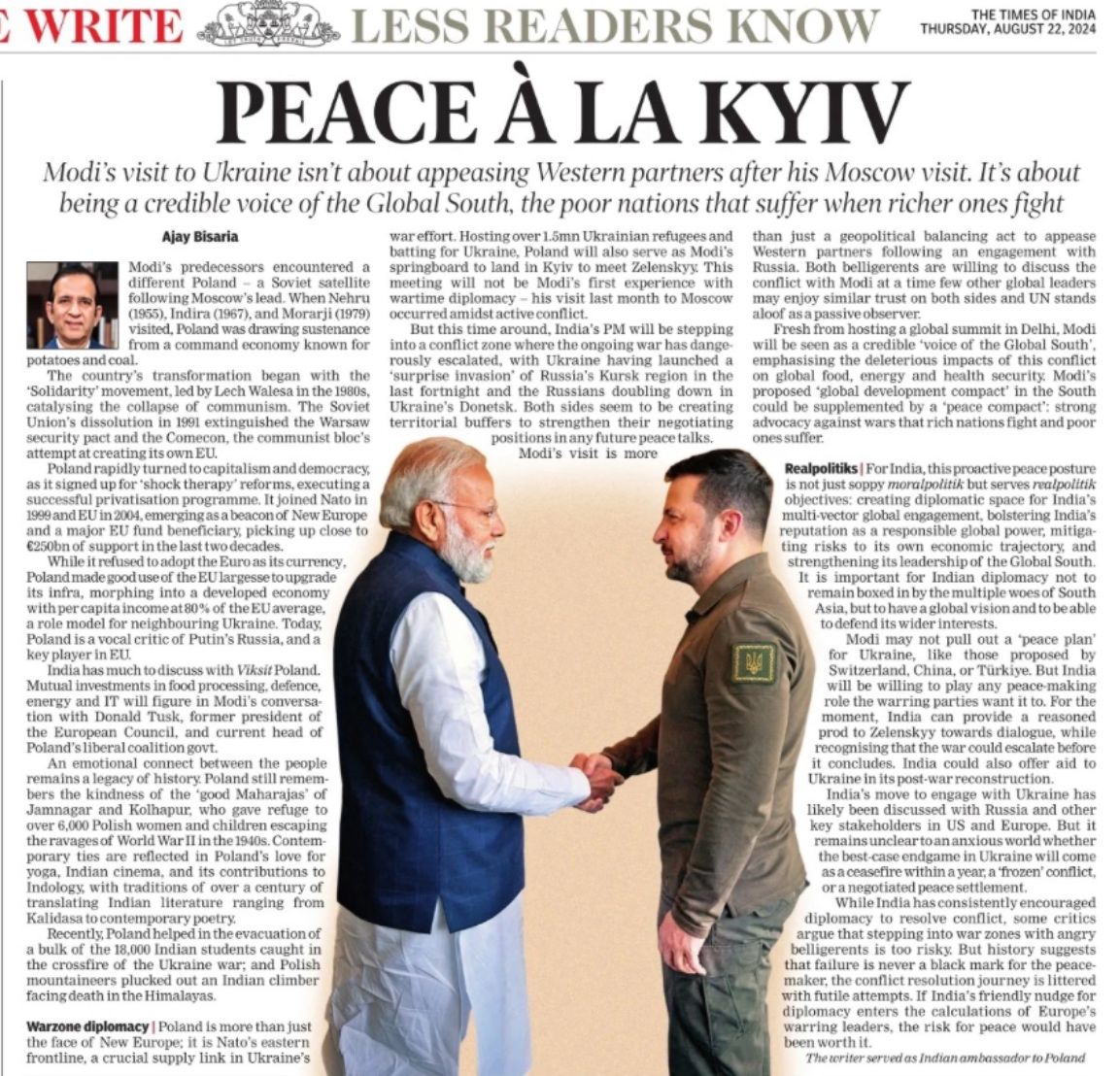Peace À La Kyiv
Narendra Modi is on a bold diplomatic mission in an active war zone in the heart of Europe. His visit is the first in 45 years by an Indian prime minister to Poland and the first to independent Ukraine.
Polishing Ties
Modi’s predecessors encountered a different Poland—a Soviet satellite following Moscow’s lead. When Nehru (1955), Indira (1967), and Morarji (1979) visited, Poland was drawing sustenance from a command economy known for potatoes and coal. But the country’s transformation began with the ‘Solidarity’ movement, led by Lech Walesa in the 1980s, catalysing the collapse of communism. The Soviet Union’s dissolution in 1991 extinguished the Warsaw security pact and the Comecon, the communist bloc’s attempt at creating its own EU. Poland rapidly turned to capitalism and democracy, signing up for ‘shock therapy’ reforms and executing a successful privatisation program. Poland joined NATO in 1999 and the EU in 2004, emerging as a beacon of New Europe and a prominent EU fund beneficiary, picking up close to 250 billion euros of support in the last two decades. While it refused to adopt the euro as its currency, Poland used the EU largesse to upgrade its infrastructure, morphing into a developed economy with per capita income at 80% of the EU average, a role model for neighbouring Ukraine. Today, Poland is a vocal critic of Putin’s Russia and a key player in the European Union.
India has much to discuss with Viksit Poland. Mutual investments in food processing, defence, energy, and IT will be discussed in Modi’s conversation with Donald Tusk, the former President of the European Council and current head of Poland’s liberal coalition government. An emotional connection between the people remains a legacy of history. Poland still remembers the kindness of the ‘good Maharajas’ of Jamnagar and Kohlapur, who gave refuge to over 6000 Polish women and children escaping the ravages of World War II in the 1940s. Contemporary ties are reflected in Poland’s love for yoga, Indian cinema, and its contributions to Indology, with traditions of over a century of translating Indian literature ranging from Kalidasa to contemporary poetry. Recently, Poland helped in the evacuation of a bulk of the 18,000 Indian students caught in the crossfire of the Ukraine war, and Polish mountaineers plucked out an Indian climber facing death in the Himalayas.
Poland is more than just the face of New Europe; it is NATO’s eastern frontline, a crucial supply link in Ukraine’s war effort. Hosting over 1.5 million Ukrainian refugees and batting for Ukraine, Poland will also serve as Modi’s springboard to land in Kyiv to meet President Zelensky. This meeting will not be Modi’s first experience with wartime diplomacy—his visit last month to Moscow occurred amidst active conflict. But this time around, India’s PM will be stepping into a conflict zone where the ongoing war has dangerously escalated, with Ukraine having launched a ‘surprise invasion’ of Russia’s Kursk region in the last fortnight and the Russians doubling down in Ukraine’s Donetsk. Both sides seem to be creating territorial buffers to strengthen their negotiating positions in future peace talks.
Modi’s visit is more than a geopolitical balancing act to appease Western partners following an engagement with Russia. Both belligerents are willing to discuss the conflict with Modi at a time when few other global leaders may enjoy similar trust on both sides, and the UN stands aloof as a passive observer. Fresh from hosting an international summit in Delhi, Modi will be seen as a credible ‘voice of the Global South,’ emphasising the deleterious impacts of this conflict on global food, energy and health security. Modi’s proposed ‘global development compact’ in the South could be supplemented by a ‘peace compact’: strong advocacy against wars that rich nations fight and poor ones suffer.
Realpolitik?
For India, this proactive peace posture is more than just soppy realpolitik. Still, it serves realpolitik objectives: creating diplomatic space for India’s multi-vector global engagement, bolstering India’s reputation as a responsible global power, mitigating risks to its economic trajectory, and strengthening its leadership of the Global South. It is essential for Indian diplomacy not to remain boxed in by the multiple woes of South Asia but to have a global vision and to be able to defend its broader interests.
Modi may not pull out a ‘peace plan’ for Ukraine like those proposed by Switzerland, China, or Turkey. But India will be willing to play any peacemaking role the warring parties want. For now, India can provide a reasoned prod to Zelensky towards dialogue while recognising that the war could escalate before it concludes. India could also offer aid to Ukraine in its post-war reconstruction. India’s move to engage with Ukraine has likely been discussed with Russia and other key US and European stakeholders. But it remains unclear to an anxious world whether the best-case endgame in Ukraine will be a ceasefire within a year, a ‘frozen’ conflict, or a negotiated peace settlement.
While India has consistently encouraged diplomacy to resolve conflict, some critics argue that stepping into war zones with angry belligerents is too risky. But history suggests that failure is never a black mark for the peacemaker; the conflict resolution journey is littered with futile attempts. If India’s friendly nudge for diplomacy entered the calculations of Europe’s warring leaders, the risk for peace would have been worth it.
An edited version was first published in Times of India on August 22, 2024
